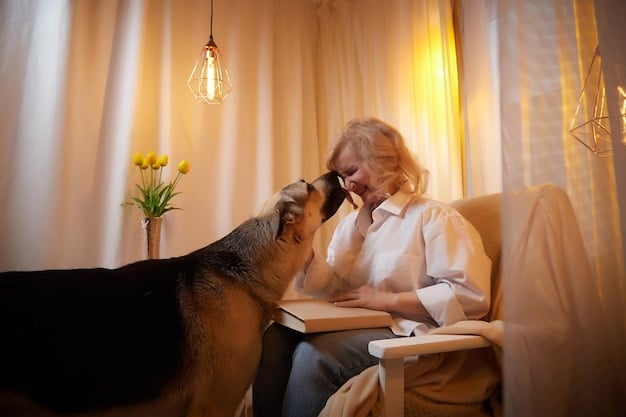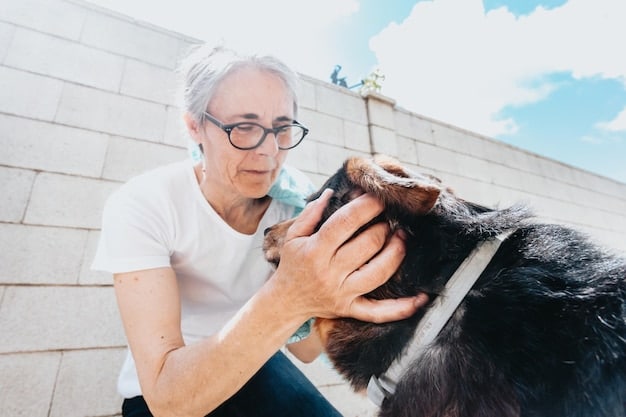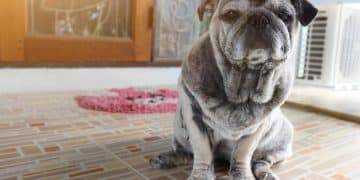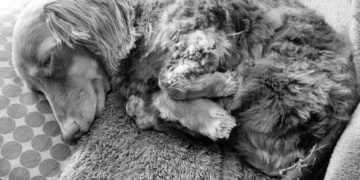Canine Cognitive Dysfunction: Spotting Early Signs & Management in 2025

Canine Cognitive Dysfunction (CCD), often called dog dementia, is a neurodegenerative disease affecting older dogs; recognizing the early signs like disorientation, changes in social interaction, sleep disturbances, and memory loss is key for effective management strategies to improve your dog’s quality of life in 2025.
Is your senior dog showing signs of confusion, forgetfulness, or altered sleep patterns? It could be Canine Cognitive Dysfunction (CCD), a condition similar to Alzheimer’s in humans. Recognizing the early signs of Canine Cognitive Dysfunction: Early Signs and Management Strategies for a Healthier 2025 is crucial for providing the best care and improving your furry friend’s quality of life.
Understanding Canine Cognitive Dysfunction
Canine Cognitive Dysfunction, often referred to as dog dementia, is a progressive neurodegenerative disorder that primarily affects older dogs. It’s characterized by a gradual decline in cognitive abilities, impacting memory, learning, and awareness. Understanding this condition is the first step in providing appropriate care for your aging companion.
What Causes CCD?
The exact causes of CCD are not fully understood, but several factors are believed to contribute to its development. These include aging-related changes in the brain, such as the accumulation of beta-amyloid plaques, decreased blood flow, and oxidative stress.
Risk Factors
While any dog can develop CCD, certain factors may increase the risk. Age is the most significant risk factor, with the condition being more prevalent in dogs over the age of 10. Some studies also suggest a possible genetic predisposition in certain breeds.

Recognizing the potential causes and risk factors can help you be more vigilant in monitoring your dog for early signs of cognitive decline. Regular veterinary checkups are essential for early detection and intervention.
Early Signs of Canine Cognitive Dysfunction
Recognizing the early signs of CCD is crucial for timely intervention and management. These signs can be subtle at first but tend to worsen over time. Being attentive to changes in your dog’s behavior and abilities is essential for early detection.
Disorientation and Confusion
- Getting lost in familiar places, such as their own home or yard.
- Staring blankly at walls or into space.
- Appearing confused or disoriented during walks.
Changes in Social Interaction
- Decreased interest in interacting with family members.
- Reduced enthusiasm for playtime or walks.
- Increased irritability or aggression towards familiar people or pets.
Sleep Disturbances
Changes in sleep patterns are a common sign of CCD.
- Increased restlessness or pacing at night.
- Sleeping more during the day and less at night.
- Vocalization or barking during sleep.
These behavioral changes, while concerning, are important clues that your dog may be experiencing cognitive decline. Document any observed symptoms and discuss them with your veterinarian for a proper diagnosis.
Diagnosing Canine Cognitive Dysfunction
Diagnosing CCD can be challenging as there is no single definitive test. The diagnosis is typically based on a combination of behavioral observations, medical history, and ruling out other potential causes of the symptoms. A thorough veterinary examination is essential.
Behavioral Assessments
Your veterinarian will likely ask detailed questions about your dog’s behavior, including the onset, frequency, and severity of the observed symptoms. Video recordings of your dog’s behavior can be helpful in providing valuable information.
Physical and Neurological Exams
A physical exam will help rule out other medical conditions that could be causing similar symptoms. A neurological exam may be performed to assess your dog’s reflexes, balance, and coordination.
Diagnostic Tests
While there’s no specific test for CCD, diagnostic tests may be used to rule out other conditions, such as:
- Blood tests to check for organ function and hormonal imbalances.
- Urine tests to assess kidney function and detect infections.
- Imaging tests (e.g., MRI or CT scan) to visualize the brain and rule out tumors or other structural abnormalities.
A comprehensive diagnostic approach is necessary to accurately diagnose CCD and differentiate it from other conditions that may mimic its symptoms. Early and accurate diagnosis is critical for implementing effective management strategies.

Management Strategies for CCD
While there is no cure for CCD, various management strategies can help slow its progression and improve your dog’s quality of life. These strategies focus on providing a stimulating environment, managing symptoms, and supporting overall health.
Environmental Enrichment
Providing a stimulating environment can help maintain cognitive function.
- Regular exercise: Daily walks and playtime can help keep your dog mentally and physically active.
- Interactive toys: Puzzle toys and treat-dispensing toys can provide mental stimulation and engagement.
- Social interaction: Maintain social interaction with family members and other friendly dogs.
Dietary Modifications
Certain dietary changes may help support brain health.
- Antioxidant-rich foods: Include foods rich in antioxidants, such as blueberries, spinach, and carrots.
- Omega-3 fatty acids: Supplement with omega-3 fatty acids, which have been shown to have neuroprotective effects.
- Prescription diets: Consider a prescription diet specifically formulated for cognitive health.
Medications and Supplements
Your veterinarian may prescribe medications or recommend supplements to help manage specific symptoms of CCD.
- Selegiline: This medication can help improve cognitive function by increasing dopamine levels in the brain.
- SAMe (S-adenosylmethionine): This supplement may help improve cognitive function and reduce anxiety.
Implementing these management strategies can help slow the progression of CCD and improve your dog’s overall well-being. Consistency and patience are key to successful management.
Creating a Supportive Home Environment
Adjusting your home environment to accommodate your dog’s cognitive decline is essential for their safety and comfort. Simple changes can make a big difference in helping your dog navigate their surroundings and maintain a sense of security.
Maintain a Routine
Dogs with CCD often benefit from a consistent daily routine.
- Regular feeding and walking schedules.
- Consistent bedtime and wake-up times.
- Predictable playtime and interaction patterns.
Ensure Safety
Take steps to ensure your dog’s safety and prevent accidents.
- Block off stairs or other hazardous areas.
- Use baby gates to confine your dog to safe areas.
- Provide soft bedding in a quiet, comfortable space.
Provide Visual Cues
Visual cues can help your dog navigate their environment.
- Use nightlights to improve visibility, especially at night.
- Place familiar objects in consistent locations.
- Use contrasting colors on steps or doorways to improve visibility.
By creating a supportive and predictable home environment, you can help minimize confusion and anxiety for your dog. These adaptations can significantly improve their quality of life.
Seeking Veterinary Support
Ongoing veterinary support is crucial for managing CCD effectively. Regular checkups and consultations with your veterinarian can help monitor your dog’s condition, adjust treatment plans, and address any new concerns that may arise. Building a strong partnership with your vet is essential.
Regular Checkups
Schedule regular veterinary checkups to monitor your dog’s cognitive function and overall health.
- Discuss any new or worsening symptoms with your vet.
- Undergo regular physical and neurological exams.
- Monitor response to medications and supplements.
Symptom Management
Work with your veterinarian to manage specific symptoms of CCD.
- Address sleep disturbances with medication or behavioral modifications.
- Manage anxiety or aggression with appropriate therapies.
- Provide pain relief for any underlying medical conditions.
Palliative Care
As CCD progresses, focus on providing palliative care to ensure your dog’s comfort and well-being.
- Maintain a high quality of life with appropriate pain management.
- Provide emotional support and companionship.
- Consider hospice care options for end-of-life support.
Seeking ongoing veterinary support is an important aspect of managing CCD and ensuring the best possible quality of life for your beloved companion. Your vet can provide valuable guidance and support throughout the progression of the disease.
| Key Point | Brief Description |
|---|---|
| 🧠 Early Signs | Disorientation, sleep changes, and reduced social interaction are key indicators. |
| 🏡 Home Adjustments | Maintain routine, ensure safety, and provide visual cues for easier navigation. |
| 🐾 Veterinary Support | Regular checkups and symptom management are crucial for quality of life. |
| 🍎 Dietary Changes | Include antioxidant-rich foods and Omega-3 supplements to support brain health. |
Frequently Asked Questions (FAQ)
▼
CCD is a neurodegenerative disease in older dogs, similar to Alzheimer’s in humans. It affects memory, learning, and awareness. Recognizing the symptoms early is key to management.
▼
Early signs include disorientation, changes in social interaction, sleep disturbances, and loss of learned behaviors. These symptoms may be subtle initially but worsen over time.
▼
Diagnosis is based on behavioral assessments, physical and neurological exams, and ruling out other conditions. There’s no single test, but a comprehensive approach helps confirm CCD.
▼
No, CCD cannot be cured, but management strategies can slow its progression and improve quality of life. These include environmental enrichment, dietary changes, and medication.
▼
Maintain a consistent routine, create a safe environment, provide visual cues, and ensure regular veterinary checkups. These measures help minimize confusion and improve comfort.
Conclusion
Recognizing and managing Canine Cognitive Dysfunction is essential for providing the best possible care for your aging dog. By understanding the early signs, seeking veterinary support, and creating a supportive home environment, you can help improve your furry friend’s quality of life and ensure they remain comfortable and happy in their senior years.





